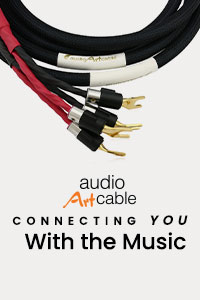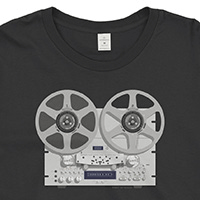JBL L-100 Century Loudspeakers
 The first pair of “real” HiFi speakers I’d ever heard were JBL’s, a pair of L-26’s to be exact, with orange grille cloth and light oak cabinets. You never forget your first. At 13 years old, I was highly impressed when the salesman put a copy of Steely Dan’s Can’t Buy a Thrill on the Dual turntable and let it rip. “Reeling in the Years” sounded way better than it ever did on the Zenith table radio at home.
The first pair of “real” HiFi speakers I’d ever heard were JBL’s, a pair of L-26’s to be exact, with orange grille cloth and light oak cabinets. You never forget your first. At 13 years old, I was highly impressed when the salesman put a copy of Steely Dan’s Can’t Buy a Thrill on the Dual turntable and let it rip. “Reeling in the Years” sounded way better than it ever did on the Zenith table radio at home.
There would be no buying JBL’s that day, but I did buy a copy of Stereo Review. (Stereophile was a fringe magazine back then, and I would not encounter it and TAS for a few more years.) On the inside cover was a JBL ad, featuring the L-100 Century. I asked the sales guy, who by now had become pretty tired of answering questions from a kid who obviously wasn’t going to buy anything today how much a pair of these monsters cost. “A lot more than you’ve got, kid.” I found out later on that the MSRP for a pair of Century 100s back in 1973 was $273 each.
And so began a life-long interest in HiFi and a disdain for HiFi salesmen.
Introduced at CES in 1970, the L-100 was built upon the strength of JBL’s highly successful 4310 studio monitors. Just like the auto-racing philosophy of selling on Monday what you ran on Sunday, the audio enthusiast of 1973 saw the L-100 as something to aspire to, including yours truly. They must have stapled my picture up in the employees lounge because the next time I visited the HiFi shop, all of the salesmen were instantly busy. The grail I pursued was in the far back room, with all of the McIntosh gear and was off limits. I knew the guys inside listening would have to come out of there sooner or later, and when they did, I would dash right in.
Twenty minutes later, I got my chance. And while my first listen of these speakers would last only about 90 seconds before I was shown to the door, it was awesome. This was the way Led Zeppelin was supposed to sound, larger than life, powered by the glow of a McIntosh MC275 power amplifier. Little did I know it would be more than 30 years before I would acquire either of these treasures.
The 48 cent solution
After a brief listening session with the JBL L-166’s that now reside at staff writer Jerold O’Brien’s house, I was still jonesing for a pair of L-100’s. That metal-dome tweeter and a bit of a midrange hole present in the L-166’s just wasn’t doing it for me, so I didn’t miss sending them away, though the sculpted metal grilles were very cool. Over the recent Memorial Day weekend, my JBL dreams would come true. They had been taunting me all week, hovering at $299, so I was wondering if I’d actually be able to steal them for that price. The owner specified local pickup and I was feeling lucky after a pep talk from Henry Rollins just the night before. “Shopping on Ebay is war. You have to win it!”
A recent article on Ebay strategy said to always add 49 cents to the dollar amount you are bidding, and in the end, that’s what saved the day. As I counted down from the last 10 seconds, and pressed “confirm” with two seconds on the clock, I had bid $410.49 and the JBL’s were mine. Yeah. A quick email to the seller confirmed that I could pick them up immediately. “I’ve got 10 emails already wanting these, so if you can’t make it here today, I’ll sell them to someone else.” I was off. Incidentally, I actually won them by 48 cents; the bid before mine was $410.01.
$350-$500 seems to be the going price for a clean pair of L100’s, more if they have the grilles. Thanks to the guys at Foam Trends (www.foamtrends.com), not having the grilles is not a deal breaker. They can make you new foam in any of the standard JBL colors, or charcoal grey. You can purchase a pair of foam inserts for $129 and a pair of frames for $129 if yours aren’t perfectly spiffy. The coveted JBL badge is a little tougher to find, but usually $25-$50 for a clean pair. Fortunately, the badges on these were pristine.
The owner’s manual can be downloaded from the JBL website at no charge, and there are a handful of people selling copies for about $12. Used drivers seem to be plentiful, with woofers costing about $125 each. Midrange drivers are in the $50-$150 a pair range, and the tweeters slightly less.
Much like buying a vintage car, buying the best example you can afford is usually the best long-term strategy. A bargain pair might end up costing more in the long run by the time you find all the right bits.
Walking into the seller’s house was definitely a blast to the mid ’70s. His house was full of ’70s vintage speakers and amplifiers, but primarily speakers. He had the L-100’s playing through a MCS receiver, and at that moment, I wondered if perhaps I had let fond memories get the best of me. Most of the women with whom I went to high school look pretty scary on Facebook these days, and the sound of these speakers were giving me the same reality bitch slap.
Bright, bright, bright. Now I remember why, after I became a “serious” audiophile, we used to smirk that JBL stood for “junk but loud.” But I had already paid the man and after all, there were speaker vultures waiting to grab the booty. So we loaded this almost flawless pair of L100’s into my trunk, and I was back in the studio in just over an hour.
The only thing missing was the period-correct square foam grilles that the L100’s were famous for. The original owner had them recovered in orange grille cloth some time ago. I started with a vintage Marantz 2275 receiver, but this sounded much too bright. With the trusty Marantz 8b in the shop, I ended up finding bliss with the PrimaLuna Prologue 1 that we reviewed last issue. The midrange magic and softer top end of the EL34 tubes was the perfect match for the somewhat forward L-100’s.
Source material was provided by the Sooloos music server via the dCS Paganini stack, fed directly into the ProLogue 1. Standard Radio Shack 14-gauge speaker wire was used, just like back in the ’70s.
Surprisingly good
I queued up a late ’60s/early ’70s superset on the Sooloos and eased back into the listening-room couch for a pleasant session. Granted, these speakers did not have the finesse that my GamuT S-9’s possess, but they did rock.
Overall, top-to-bottom coherence was fantastic and the midrange clarity was well on par if not better than a lot of today’s speakers in the $1,000 – $2,000 range. The soundstage presented was incredibly wide, easily extending a few feet beyond the speaker boundaries. Switching back to a modern pair of high-quality speakers reveals what is missing; precise spatial cues and low-level resolution is not presented with the L100’s. But that’s not the point. Much like another one of my favorite speakers, the Vandersten 2 series, these do a nice job with what they do handle, and if you use them with the music of the period, you might be surprised by just how much fun these speakers can be with the right amplifier.
After spending some time with various speaker placement options, the L100’s worked best well out in the room, about five feet from the walls, only about six feet apart, with the cabinets about 17 inches from the floor. This floor position ended up being similar to the perfect position for the Harbeth 40.1’s.
If you enjoy a fair amount of classic rock music, there’s a pretty good chance some of your favorites were mastered on the pro version of the L100, so they give you a great feel of what these classics really sounded like in the control booth. Trendy adult chemical amusement aids optional, of course.
Listening to “I’m So Afraid” from Fleetwood Mac’s Fleetwood Mac shook the floor with the opening bass line. Moving along to 10cc’s “I’m Not in Love” from The Original Soundtrack offered up a huge soundstage in both the left-right and front-back dimensions. Hours later, I found myself pretty enamored with this slice of audio’s history. The JBL L-100 was definitely a lot better than I remembered, especially with tube amplification.
My only curiosity was that considering how good these speakers sound at moderate levels, why did so many engineers feel the need to crank the hell out of these in the studio? -Jeff Dorgay






